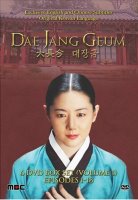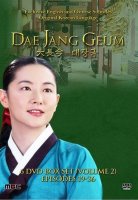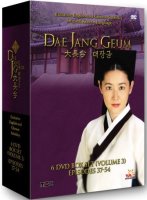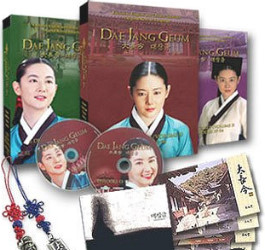NOTE: Contest for free copy of Volume 1 ($90 value) and more.
See bottom of review HERE.
Dae Jang Geum
Written by Kim Yeong-hyeon
Directed by Lee Byoung-hoon
Originally aired in Korea, Sept, 2003 to March, 2004
Cast
Lee Young Ae, Ji Jin Hee
Yang Mi Kyung, Kyun Mi Ri
Hong Li Na, Park Eun Hye
Lim Ho, Yeo Woon Kye
Production Studio:
MBC Television, Korea
Worldwide DVD Distributor
YA Entertainment (USA)
|
or Dae Jang Geum Ultimate Gift Collection - Volumes 1, 2 + 3 |
||
|
|
Thinking of buying from YesAsia? CLICK HERE and use THIS UPDATED BEAVER PAGE to source their very best... |
|
Video:
Aspect ratio: 4:3
Region 0 (all) : NTSC
Feature: 480i
Audio:
Korean DD 2.0
Subtitles:
Feature: English & Chinese
Extras
Photo Gallery
Character Introductions
54 episodes, approx 60 minutes per episode
3 box sets, complete on 18 discs (Volumes I-III)
Each box: 2 volumes, each with 3 discs
Release Dates: February (Vol. I), April (Vol. II) & May (Vol. III), 2005
Review by Leonard Norwitz
Dae Jang Geum (aka: The Jewel in the Palace) ~ Comment
(see Introduction to Korean Drama HERE)
A glance Korean Wiz HERE points out just how many Korean TV dramas have been aired over the last decade or so. Today, I counted over 400! When you consider that these are, on average, 16-20 hour series, spread, for the most part, over three television networks, with no chance or intention of being "renewed" for another season, it truly boggles the mind. Of course, quality is necessarily variable, but considering the ferocity of the competition, the intention is always to create a marketable product.
.jpg) |
The great majority of these dramas take place in a contemporary setting, and most of them have a strong love story component. A few are historical dramas, based on actual persons. Some, not many, are much longer than the usual 16-20 hours – 50 hours and more – and offer the opportunity for an emotional immersion, the likes of which are not remotely approached on American television no matter how many seasons a show is renewed for. Dae Jang Geum is such a drama.
Its 54 one-hour episodes were originally aired over a six-month period. Typical for Korean drama, that's two episodes per week. As I say, the potential for a powerful emotional connection is infectious. A television series that gets a 25-30% share will offer Koreans something to talk about for weeks and months. Imagine if half the television-watching population is tuning into the same developing story for months at a time! But so it was with Dae Jang Geum!
Dae Jang Geum was the show that introduced me to Korean television drama in 2005 and it set the bar high for all that followed. I am fond of describing it to the unsuspecting as a kind of Upstairs Downstairs scenario where a considerable amount of the drama plays out in the kitchen. In some ways, it's not a facile comparison, for they are almost exactly the same length - except that the BBC production, which took over five years to film, suggested more a play than a movie. Not so with this Korean series, which boasts production values second to none for a TV show from any country.
The central character of Dae Jang Geum is its real-life heroine, Suh Jang-geum, who lived about 500 years ago – about the time of Columbus and when Korea was under the rule of the long-lived Joseon Dynasty. You can imagine how little is known about people who were neither royalty nor generals so long ago, let alone a woman. The historical (or legendary, if you so choose) Jang-Geum was orphaned as a child and found her way to the Royal Kitchen where she continued her education in the arts of cooking and health. She had particular gifts that bordered on pharmacology and medicine, eventually becoming the first female physician to the king – this was at a time when it was forbidden for a woman other than the royal concubine or royal mother to lay hands upon his royal highness. You can also imagine the weight of opposition that she would have had to face in order to rise to such a position of influence and authority. Sounds like the makings for a terrific, though often subtle, political thriller – and so it is. Even so, there was still room in its 54 hours for assorted palace intrigues, assassins, plagues and foreign military incursions.
But the political aspects of the royal household aside, it is the character of Jang-Geum herself, sympathetically portrayed by Lee Young-Ae (more about her in a moment) that catches our attention and holds our heart in her hands. Everyone loves an underdog, few people more than Koreans – and they really know how to draw us into their internal and external conflicts. You might say that Jang-Geum is both driven and unequivocally moral – something you can say about very few people: Gandhi, Washington, Mandela, Lincoln, Joan of Arc come to mind. What makes these people stand out is the sheer volume and viciousness of the opposition. In her much smaller arena, the same could be said for Suh Jang Geum, of whom the king would one day bestow the title "Dae" Jang Geum, the Great Jang Geum.
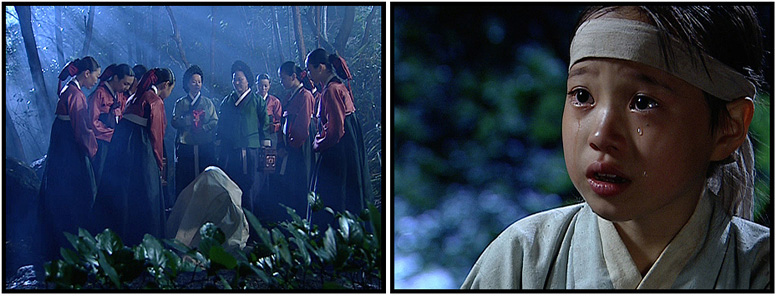 |
Jang Geum is one hell of a cook, true enough, but more than that – and the thing that separates her from Julia Child or Remy the Rat – is her understanding of why ingredients work the way they do – not only on the stove, but also in the body. These, together with her instructions that feel suspiciously like Yoga and meditation, she is a natural healer, though there was, as yet, no palace occupation with that job description.
One of countless stories that place her own guiding principle to create food that nourishes the body despite the political consequences is found in Episodes 18/19: A visiting dignitary from China has arrived at the palace. Jang-Geum and her mentor, Lady Han, are asked to prepare and present dishes that are the spicy showpieces of Oriental cuisine – this, despite the fact that it is known that the visitor has a health condition which would be made worse if he were to eat such food. Jang Geum and Lady Han stick to their guns in the face of politics, appetites and possible imprisonment or death as they prepare dishes consistent with his medical condition.
Sounds like a real page-turner doesn't. Probably not. Yet I have played this episode out of context to many, and hardly a dry eye is seen.
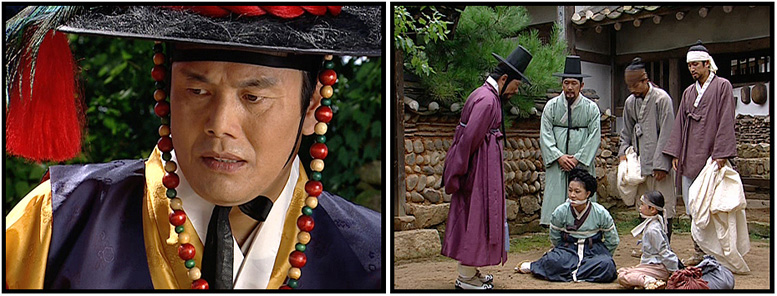 |
The series is beautifully produced. While most of the action, if we could call it that, takes place in palace chambers and the areas around the kitchen – with, by the way, some appetizing photography of food and its preparation – the production also leads us to nearby villages, meadows, seashores and some beautiful, and unavoidably real, snow. We can see where every won was spent: costumes, sets (including working palaces to some extent), art direction and the photography to show it off, beautiful music, and - without a single offending exception - excellent acting and characterizations – this, remember, over a 54 hour show that involves scores of characters, two dozen of which we get to know fairly well, and will miss by its end.
If nothing else, Dae Jang Geum is gorgeous to look at, as these screenshots will testify. Regardless of location – in the palace chambers or the kitchen, in the neighboring villages or in the fields, or in her exile at Jeju Island; day or night, the colors are vivid, and never unnaturally so.
Some of the characters seem at first stereotypically good or bad, silly or greedy, wise or foolish. But even the most transparent of them soon takes on dimension and complexity, none more so that Jang Geum's rival at the kitchen, Choi Keum-Young. Keum-Young is both impressed by Jang-Geums' skills and resourcefulness, and has been ever since they were children inductees into the royal kitchen school. But as Oscar Hammerstein put so well, in order to hate, you have to be carefully taught, and from a young age. Keum-Young's paternal aunt is Lady Choi (played with simmering menace by Kyun Mi Ri (who plays a similar part in the more recent historical drama, Jumong.) She is the person – unknown to just about everyone that counts - that Jang-Geum's mother implicated in the accusation that led to her being poisoned. Lady Choi, too, was carefully taught – about ambition, status, and the necessity of doing whatever it takes to achieve it, and she instills in her reluctant niece with a vengeance the same virtues with she was indoctrinated into the family business. Keum-Young is helped by two convenient jealousies: the first is that Jang-Geum is more popular and more respected amongst her peers, and the second is that she harbors a secret love for Ming Jung-Ho, the man whose life was once saved by Jang-Geum, and for whom Jang-Geum also has a deep, if unexpressed, affection.
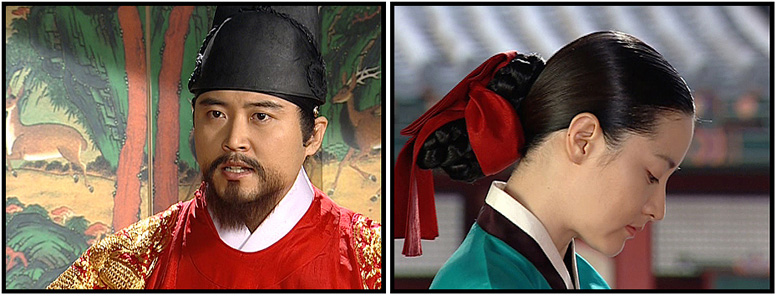 |
So, a few words about the actress who plays our heroine, Lee Young-Ae. By the time she began filming Dae Jang Geum Young-Ae was already 32 and had been working in Korean TV dramas for ten years. She gained international prominence for Park Chan Wook's 2000 film, JSA: Joint Security Area. Ms. Lee played the investigator of a murder at a North Korean security outpost. While I believe it was more due to the film and its subject than her performance, Lee Young-Ae began to get choice roles, the next being Hur Jin-Ho's One Fine Spring Day the following year. Filming Dae Jang Geum took over a year and took some courage since movies were just beginning to take off for her. But in Korea, A-list actors do both TV and film, so the decision was a smart one.
Lee Young-Ae is not your typical Asian beauty. Rather it is her quiet, reassuring manner and self-effacing body language that makes her perfect for Suh Jang-Geum, for her character, being of low birth, had to succeed in her training without bringing too much attention to herself. As it happened, her talents and her tenacity were Jang-Geum's greatest liabilities, for others in power were jealous of her potential. Young-Ae is able to make us believe in both Jang-Geum's artless sincerity as well as her quest to realize her mother's dying wish for her: the highest possible position in the royal kitchen.
That said, Dae Jang Geum comes with the baggage of its genre: the flashback and the accidental meeting (or, more often, accidentally just happening to be there in time to witness something that will turn the plot this way or that.) Thus, a score of 9, and not 10. It may take some getting used to, but my suggestion is not to fight it, and smile sympathetically.
Dae Jang Geum
The Score Card
The Series : 9
The story begins, rather uncharacteristically for all that follows, with two gruesome killings, both by poison, though some 14 years apart. A royal order commands the deposed queen to take poison. A minister feigns illness so that he does not have to be present at the queen's execution. One of his royal guard soldiers who played an active role in her death is profoundly affected by the event. He wanders through the forest and meets a hermit who tells him of his fate regarding three women: One he has already killed, another he will save, and yet another will kill him. He decides to shun all contact with women forever. Years later, a kitchen lady is forced to take poison to cover up her knowledge of suspicious behavior of another up and coming peer. However, a friend intervenes, and she survives the potion, but only barely. She is found, near death, by the soldier, who cannot resist her circumstances or his fate. Together they flee, take on new identities, and try to live an ethical life. They make a child who is taught all the precepts that these two menschen can offer. This, of course, is Jang Geum. And this is only the first episode.
By the middle of the second episode, her father is dragged away for his "crime" and she and her mother are on the run. By its end, Jang Geum is orphaned, but not before her mother instills in her the instruction to return to the royal kitchen from which she herself was expelled and murdered, and in due course take her rightful place at the top of its political food chain.
Early on, she meets the man for whom she has a secret affection – and secret it will have to remain – for there is no dallying permitted in the royal palace at the risk of being thrown out. One of the special gifts of this series is how delicately, yet incisively, Jang Geum and Min Jung-Ho (who harbors a similar affection for the unknown person who once saved his life, but not knowing it is she) are kept apart for the duration.
For the next fifty episodes, Jang Geum is challenged with one cliffhanger after another: the threat – and more - of expulsion, of imprisonment and torture. But through it all, she maintains her sense of purpose – in some ways not unlike Richard Kimble, helping others, no matter the risk.
Edition: 8
The original edition (and its later reissue in a single box set with one disc per slimcase), was produced by Bitwin has been out of print for some while, so my remarks are to some extent moot. All the same, DVD Beaver readers will want to know if they are giving up or getting something as compared to that edition. The Bitwin editions were Region 3 and were NOT subtitled in English. In both the YAE and Bitwin, each disc contained 3 episodes on average. The final disc in the YAE set includes a single extra feature of a brief Photo Gallery. On the other hand, the Bitwin set has a whole extra disc of special features: Even though, as is usual with Region 3 DVD television dramas, they are not subtitled, at least one – an hour long television show that introduces the actors from the series to a studio audience is charming and entertaining. It's fascinating to see how genuinely self-effacing most of these actors are despite their heroic status.
The image quality is very good indeed throughout the YAE set, so good in fact that it is surprising that the Bitwin is better still. The same is true for the audio.
Image : 8.5 (7/9)
The score of 8.5 indicates a relative level of excellence compared to other standard definition DVDs on a 10-point scale for SD DVDs. The score in parentheses represents: first, a value for the image on a 10-point scale that accommodates both standard and high-definition DVDs – where any score above 7 for an SD is outstanding, since the large majority of high definition DVDs are 8-9. The second number in parentheses indicates how that image compares to what I believe is the current best we can expect in the theatre or, in the case of made-for-TV fare, as first shown on television.
Dae Jang Geum was originally filmed in Digital Beta and broadcast in standard definition. YAE receives 1:1 copies made from the tapes used for broadcast. Variations in quality from one YAE production to another is largely the result of the care taken in storage and transfer in Korea. Dae Jang Geum is often of demonstrable quality. Aside from a modest, though, given the source material, inexplicable degree of jpg artifacts (noticeable at the edges of shoulders and hair and the like), there are no obvious defects or other artifacts aside from an occasional and minor amount of edge-enhancement. Even so, facial complexion, hair and eyes, and fabric textures are remarkably clear. Interestingly, the bit rates for both the YAE and Bitwin editions are about the same - if anything, higher for the YAE, though they are not as stable as on the Bitwin.
 |
Perhaps it's the consequence of how effective the show is at an emotional level, but there are times when the image appears to rival some HD in smoothness, resolution and dimensionality – this despite the jpg artifacts (which are probably only noticeable on large displays - mine is over 100 diagonal - or on Pause.) There is the usual caveat with Korean TV shows as well as some of their feature films (see my review of the Blu-ray edition of The Host reviewed HERE) to overexpose light areas in the frame, but otherwise, this is a extraordinary image, bettered in live action SD only by the likes of HBO's Rome or the Broadway Melody sequence from Singin' in the Rain. We have the impression that what we are looking at is close to the live video feed from the camera.
One comment about the aspect ratio for those of you who are used to seeing movies from recent decades on your widescreen displays, and who might feel cheated by a long show in only 4:3: Keep in mind that the area of a 4:3 image, though it does not fill a 16x9 screen, is greater than 2.4:1 on the same screen. As we let the image sweep us into the drama, especially as viewed on a big screen, we can easily let ourselves believe we are right there with the action.
Audio & Music : 7.5/9
For some odd reason, the Bitwin edition sports much better audio: it is clearer, appropriately more spacious and more dynamic. One's first impression is that the Bitwin is true stereo and the YAE may not be. That said, if it weren't for the ability to A/B the YAE and Bitwin sets, we would not only be satisfied with the YAE, we would have taken it to be excellent for a made-for TV series. An example can be heard in the first episode when Jang-Geum's father-to-be wakes up in a cave-like part of the forest. The dialog is given a touch of resonance to convey a sense of cavernous space, while the water trickles off branches and rock in the background. It's hard to imagine that this could be presented any better, but the Bitwin does just that (without subtitles, remember.) One note of caution: as is typical with Korean DVDs, and YAE releases in particular, feature is "cut" at a higher level than U.S. DVDs - the intro and menus are louder still. Keep you remote handy. Happily, thisz is only a big problem for Volume I, since the menu music for the other volumes is less exuberant.
Like the best Korean drama series, Dae Jang Geum's musical score is one of its best features. It makes selective use of a children's chorus to underscore Jang-Geum's journey from childhood to adulthood as a palace maid. Its only weakness is that the Asian and Western-derived musical themes are not sufficiently developed. Each time one of the main themes returns, we hear it in much the same way (orchestration, key, volume), which gets old quickly if you watch episodes more often than once a week, which is likely if you own the DVD. While some of the major themes are, as I say, often repeated with little or no variation, there are quite a number of music cues that are sufficiently varied that make the OST worthy of a separate purchase which, as of this date, is still in print.
Subtitles & Translation : 8
Even though this was a relatively early YAE effort, the translation here – especially when you consider the length and breadth of it – is one of their better efforts. The trick to translation is not only to convey the meaning of the original text and to present it in readable (in this case) English, but also to preserve – or, in some cases, create – the verbal character of the speaker: their unique rhythms and social class. Not all translators are also good writers, but in this case, some good ones were found. There are occasional grammatical slips and the odd word here and there, as well as what feels like a self-conscious effort to keep from swearing.
The selectable subtitles are white, readable, and not overly large, even when the image is projected onto a big screen.
Operations & Box Design : 9
One of the first things I noticed about the YAE sets is the clasp that holds the disc in place. It was the first time I encountered a completely strain-free release. I realize that such a device must cost the producers a few pennies more per box, but it astonishes me that it took Criterion – I use them as an example because they take such care elsewhere in their product - another two years before they got around to coming anywhere near such a device. Until lately, every time I attempt to release a Criterion disc from its hold I feel I should cross myself for fear of breaking the thing.
Each 3-disc volume opens neatly and solidly, without any flopping about. We have the impression that some thinking and money went into the design. On the other hand, the case that each of the pairs of 3-disc volumes slips into is altogether too tight. This is true, not only for all of Volumes I-III, but for sets printed later. YAE experiments with case presentation design, and later designs didn't have this flaw.
Each disc contains three one-hour episodes. The main menu permits the viewer to go right to the beginning of the first episode of the disc or to a new page for each episode, each with four chapters. The thumbnails don't do much for us, even if you've already watched the series. I would like to see chapter titles as well. While each episode has an introductory title sequence plus a preview at the end, the chapter stops are conveniently placed so that it is possible to skip these without missing hardly a beat.
Extras : 1
No supplementary features, as such, other than the aforementioned Photo Gallery, are included with this set. However, descriptions of four main characters are found via the main menu of the first disc of Volume 1. These include an elementary paragraph or two of text and an image (thank you) for: Suh Jang-Geum (Lee Young-Ae), Ming Jung-Ho (Ji Jin-Hee), Choi Keum-Young (Hong Li-Na), and King Jung-Jong (Lim Ho). The Photo Gallery is something of an embarrassment in that it contains, in scrapbook layout, only ten low-res pictures of the principals in the cast, in costume. My feeling is that the set would have been better off without it since it feels like an insult to have so little for such an otherwise lavish and important production.
.jpg) |
.jpg) |
.jpg) |
.jpg) |
Recommendation: 10
Despite its lack of extra features, this is a wholly recommendable series. I dare you to start the series again from the beginning and stop after the first episode.
Leonard Norwitz
LensViews
November 3rd
, 2007
|
or Dae Jang Geum Ultimate Gift Collection - Volumes 1, 2 + 3 |
||
|
|
Thinking of buying from YesAsia? CLICK HERE and use THIS UPDATED BEAVER PAGE to source their very best... |
|
RULES: Since this month's Korean Drama takes place in and
around the kitchen, our contest asks you to identify the movies (not
necessarily Korean) from which come these captures:
Name the ten titles (in English, please) to
KoreanDrama@DVDBeaver.com
Include name, shipping address, telephone number and
e-mail address with your entry.
The winner will be chosen randomly from those with the most correct
answers.
Randomly chosen winner from those who guess most of the titles
correctly; 6 runners up.
Prizes: The winner gets Volume 1 (six DVDs) of the complete series. Runners-up get the disc with the first 3 episodes...
WINNERS: The winner, who will receive Dae Jang Geum Vol.
1, is: Ilya Stone, Memphis.
The runners-up to receive the single disc sampler are: • Connie S. of
Evergreen,CO, Sharon B. of
Columbia, MD 2, and Mike W. of Boise ID
Capture 1: The Apartment
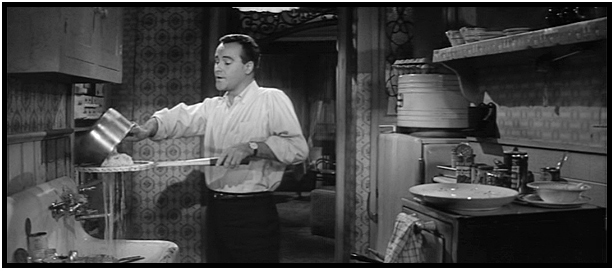
Capture 2: Gosford Park
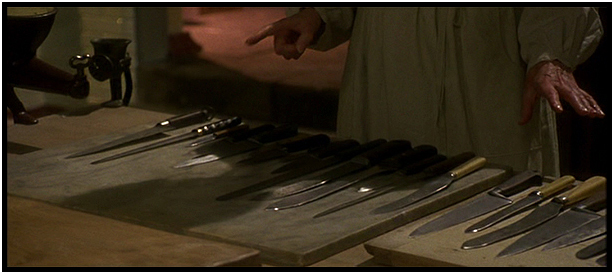
Capture 3: Sabrina
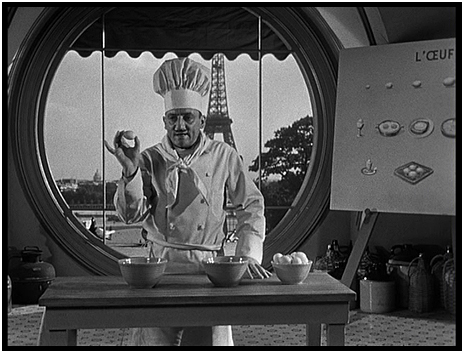
Capture 4: The Stepford Wives
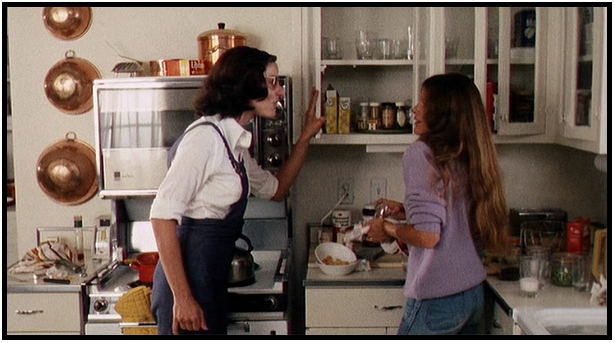
Capture 5: Mildred Pierce
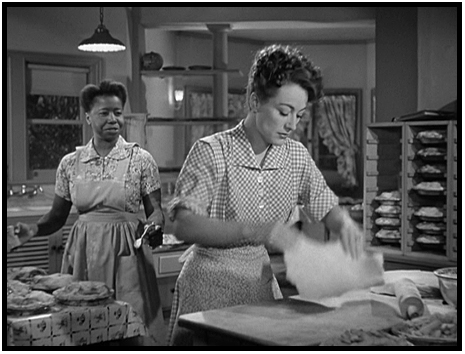
Capture 6: The Big Chill
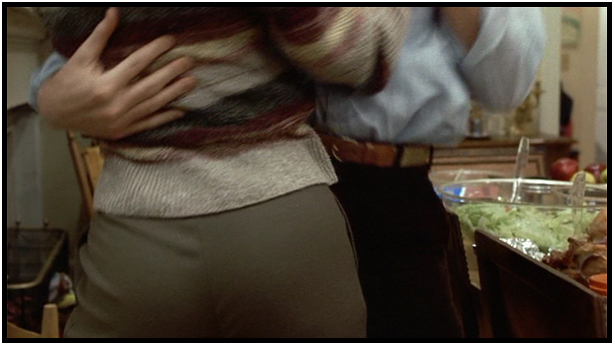
Capture 7: Mr. Blandings Builds His Dream House
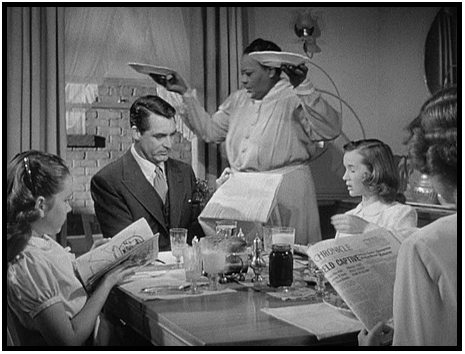
Capture 8: Forbidden Planet
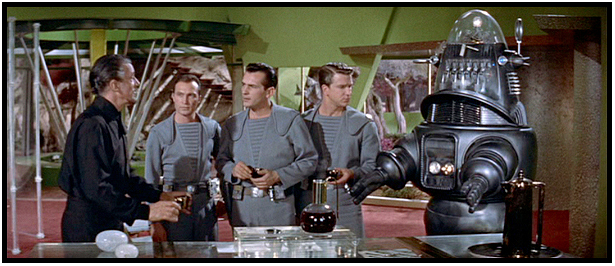
Capture 9: In the Heat of the Night
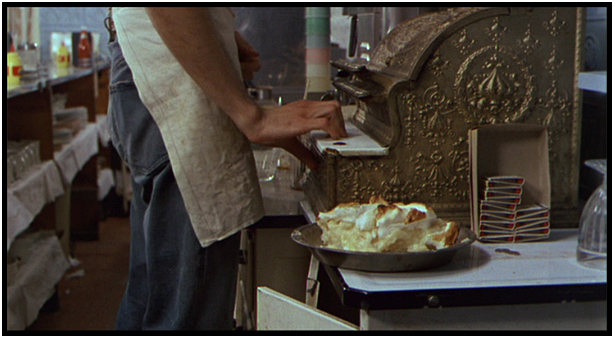
Capture 10: Hairspray
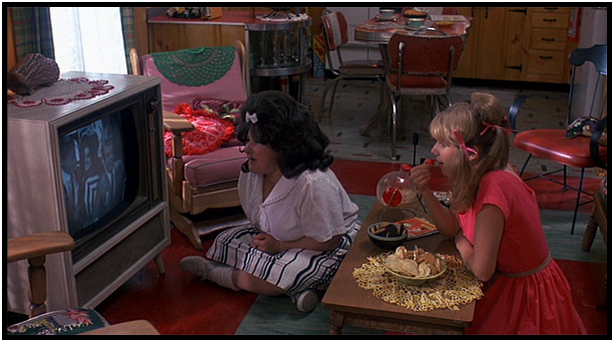
GOOD LUCK ALL!

